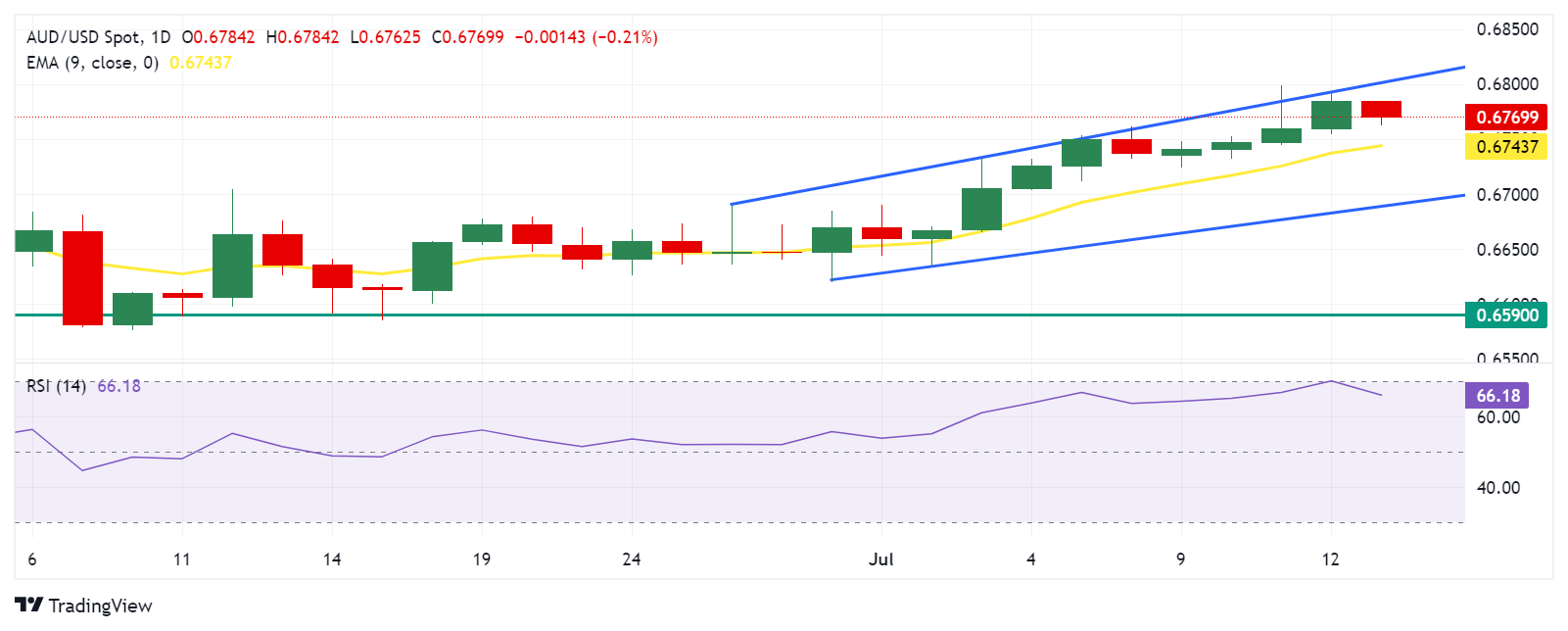- The Australian dollar could lose ground due to weaker than expected Chinese GDP data.
- China’s GDP (year-on-year) grew 4.7% in the second quarter, compared with the previous expansion of 5.3% and the 5.1% expected.
- The US dollar is gaining ground on heightened risk aversion following the assassination attempt on former US President Trump on Saturday.
The Australian Dollar (AUD) is lower on Monday, trading around its six-month high of 0.6798 hit on Thursday. In China, a close trading partner of Australia, Gross Domestic Product (GDP) grew by 4.7% year-on-year in the second quarter, compared with a 5.3% expansion in the first quarter and 5.1% expected. Weaker-than-expected China GDP data could put mild pressure on the Australian Dollar, weakening the AUD/USD pair.
The Australian dollar could continue to rise as speculation grows that the Reserve Bank of Australia (RBA) could delay its participation in the global rate-cutting cycle or even raise interest rates again. Persistently high inflation in Australia is leading the RBA to maintain a hawkish stance.
The US Dollar (USD) is strengthening on heightened risk aversion following an assassination attempt on former US President Donald Trump on Saturday. Analysts suggest that if this incident boosts Trump’s election prospects, it could lead to so-called ‘Trump victory trades’, potentially resulting in a stronger US Dollar and a steeper US Treasury yield curve, according to Reuters.
The AUD/USD pair could find support as the US Dollar (USD) could lose ground due to rising expectations of a possible Federal Reserve (Fed) rate cut in September. This anticipation is driven by the softer than expected US Consumer Price Index (CPI) data in June.
Daily Market Wrap: Australian Dollar Falls on Risk Aversion
- China’s retail sales (year-on-year) rose 2.0% in June, below the 3.3% expected and 3.7% in May. Meanwhile, the country’s industrial production for the same period showed a growth rate of 5.3% year-on-year, beating estimates of 5.0%, although slightly lower than the 5.6% in May.
- The US Core Producer Price Index (PPI) rose 3.0% year-over-year in June, beating the 2.5% expected and the previous reading of 2.6%. In addition, the preliminary Michigan Consumer Sentiment Index came in below expectations in July, registering 66.0 compared to the 68.5 forecast and 68.2 prior.
- On Friday, China’s trade balance data for June showed a trade surplus of $99.05 billion, widening from the previous figure of $82.62 billion. China’s exports (year-on-year) rose 8.6% versus the 8.0% expected and the previous reading of 7.6%. Meanwhile, imports (year-on-year) declined 2.3% compared with the previous increase of 2.8%.
- Federal Reserve Bank of Chicago President Austan Goolsbee said on Thursday that the U.S. economy appears to be on track to achieve 2% inflation. This suggests that Goolsbee is gaining confidence that the time to cut interest rates may be drawing near. He also said “My view is that this is the path to 2%,” according to Reuters.
- On Thursday, data showed that the US core Consumer Price Index (CPI), which excludes volatile food and energy prices, rose 3.3% year-on-year in June, compared with May’s 3.4% increase and the same expectation. Meanwhile, the core CPI rose 0.1% month-on-month, versus the expected and prior reading of 0.2%.
- Federal Reserve Chairman Jerome Powell stressed the urgent need to monitor the deteriorating labor market on Wednesday. Powell also expressed confidence in the downward trend in inflation, following his earlier remarks emphasizing the need for more data to strengthen confidence in the inflation outlook.
Technical Analysis: Australian Dollar Holds Its Position Above 0.6750
The Australian Dollar is trading around 0.6760 on Monday. The daily chart analysis shows that the AUD/USD pair is consolidating within an ascending channel, which indicates a bullish bias. Moreover, the 14-day Relative Strength Index (RSI) has retreated from the 70 level, suggesting a correction. However, it remains above 50, suggesting continued bullish momentum. Further decline could weaken this trend.
The AUD/USD pair could retest the upper boundary of the ascending channel near the psychological level of 0.6800.
On the downside, immediate support appears around the nine-day exponential moving average (EMA) at 0.6643. Further support is seen near the lower boundary of the ascending channel at 0.6690. A break below this level could push the AUD/USD pair towards the retracement support at 0.6590.
AUD/USD: Daily Chart
Australian Dollar PRICE Today
The table below shows the Australian Dollar (AUD) exchange rate against major currencies today. The Australian Dollar was the weakest currency against the US Dollar.
| USD | EUR | GBP | JPY | CAD | AUD | NZD | CHF | |
|---|---|---|---|---|---|---|---|---|
| USD | 0.17% | 0.16% | -0.05% | 0.05% | 0.16% | 0.20% | 0.16% | |
| EUR | -0.17% | 0.03% | -0.02% | 0.09% | 0.03% | 0.23% | 0.19% | |
| GBP | -0.16% | -0.03% | 0.04% | 0.05% | -0.00% | 0.15% | 0.16% | |
| JPY | 0.05% | 0.02% | -0.04% | 0.10% | -0.01% | 0.22% | 0.03% | |
| CAD | -0.05% | -0.09% | -0.05% | -0.10% | 0.03% | 0.15% | 0.11% | |
| AUD | -0.16% | -0.03% | 0.00% | 0.01% | -0.03% | 0.21% | 0.17% | |
| NZD | -0.20% | -0.23% | -0.15% | -0.22% | -0.15% | -0.21% | -0.05% | |
| CHF | -0.16% | -0.19% | -0.16% | -0.03% | -0.11% | -0.17% | 0.05% |
The heatmap shows percentage changes of major currencies. The base currency is selected from the left column, while the quote currency is selected from the top row. For example, if you choose the Australian Dollar from the left column and move along the horizontal line to the US Dollar, the percentage change shown in the chart will represent the AUD (base)/USD (quote).
Australian Dollar FAQs
One of the most important factors for the Australian Dollar (AUD) is the level of interest rates set by the Reserve Bank of Australia (RBA). Since Australia is a resource-rich country, another key factor is the price of its largest export, iron ore. The health of the Chinese economy, its largest trading partner, is a factor, as is inflation in Australia, its growth rate and the Trade Balance. Market sentiment, i.e. whether investors are betting on riskier assets (risk-on) or seeking safe havens (risk-off), is also a factor, with risk-on being positive for the AUD.
The Reserve Bank of Australia (RBA) influences the Australian Dollar (AUD) by setting the level of interest rates that Australian banks can lend to each other. This influences the level of interest rates in the economy as a whole. The RBA’s main objective is to maintain a stable inflation rate of 2%-3% by adjusting interest rates up or down. Relatively high interest rates compared to other major central banks support the AUD, and the opposite for relatively low ones. The RBA can also use quantitative easing and tightening to influence credit conditions, with the former being negative for the AUD and the latter positive for the AUD.
China is Australia’s largest trading partner, so the health of the Chinese economy greatly influences the value of the Australian Dollar (AUD). When the Chinese economy is doing well, it buys more raw materials, goods and services from Australia, which increases demand for the AUD and drives up its value. The opposite occurs when the Chinese economy is not growing as fast as expected. Therefore, positive or negative surprises in Chinese growth data often have a direct impact on the Australian Dollar.
Iron ore is Australia’s largest export, worth $118 billion per year as of 2021 data, with China being its main destination. The price of iron ore can therefore be a driver of the Australian dollar. Typically, if the price of iron ore rises, the AUD rises as well, as aggregate demand for the currency increases. The opposite occurs when the price of iron ore falls. Higher iron ore prices also tend to lead to a higher probability of a positive trade balance for Australia, which is also positive for the AUD.
The trade balance, which is the difference between what a country earns from its exports and what it pays for its imports, is another factor that can influence the value of the Australian dollar. If Australia produces highly sought-after exports, its currency will gain value solely because of the excess demand created by foreign buyers wanting to purchase its exports versus what it spends on buying imports. Therefore, a positive net trade balance strengthens the AUD, with the opposite effect if the trade balance is negative.
Source: Fx Street
I am Joshua Winder, a senior-level journalist and editor at World Stock Market. I specialize in covering news related to the stock market and economic trends. With more than 8 years of experience in this field, I have become an expert in financial reporting.








